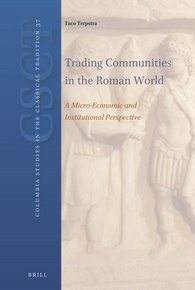this book investigates roman trade. More specifically, it investigates the trading communities that facilitated roman trade, taking a micro- economic and institutional approach to the subject. Abstract though this approach may seem, the problems addressed are concrete and down-to- earth. the leading question behind the work as a whole can be summed up in a single sentence: how did trade operate in the roman Empire under conditions of imperfect government enforcement and imperfect informa- tion? In the course of this book I will elaborate further on this question, but let me briefly explain what I mean here. the roman state commanded awe-inspiring powers of physical vio- lence and did not shy away from using them. However, unlike modern states it did not employ the powers at its disposal to enforce private con- tracts drawn up by ordinary individuals. the roman legal system, in that sense, can be said to have been ‘imperfect’. A party to a contract con- fronted with a default could not call upon the help of the roman authori- ties to make a contractual partner honor his obligations. of course, he could take a defaulter to court, but even with a favorable verdict in hand the vindicated litigant was still pretty much on his own. ordinarily, no police or military unit would have been available to back him up in put- ting the court’s ruling into effect.1 this is not to say that such help will never have been granted. there will doubtless have been instances where the roman administration—whether central or provincial—for whatever reason thought it expedient to lend some muscle to an individual litigant. But the point here is that any such help would have been random and arbitrary; it could not be relied upon. Government enforcement simply did not form part of the roman legal institution in the way it forms part of the legal institution of, for instance, the united States. Since the lightning-fast means of communication we take for granted were unavailable to the romans, information could only move as fast as sails and legs would allow. the slowness with which information trav- eled formed a serious constraint on overseas business, a constraint felt increasingly with growing distance. For anyone intending to enter into a transaction with someone in a far-away place it was difficult to assess risk;
چکیده فارسی
این کتاب تجارت رومی را بررسی می کند. به طور خاص تر، جوامع تجاری را که تجارت رومی را تسهیل می کردند، بررسی می کند، و رویکردی خرد اقتصادی و نهادی به این موضوع اتخاذ می کند. اگرچه این رویکرد ممکن است انتزاعی به نظر برسد، اما مشکلاتی که به آنها پرداخته شده عینی و اساسی هستند. سوال اصلی پشت کل این اثر را می توان در یک جمله خلاصه کرد: تجارت در امپراتوری روم در شرایط اجرای ناقص دولت و اطلاعات ناقص چگونه عمل می کرد؟ در طول این کتاب، من در مورد این سؤال بیشتر توضیح خواهم داد، اما اجازه دهید به طور خلاصه توضیح دهم که در اینجا منظورم چیست. دولت روم دارای قدرتهای مهیب خشونت فیزیکی بود و از به کار بردن آنها ابایی نداشت. با این حال، برخلاف دولتهای مدرن، از قدرتهایی که در اختیار داشت برای اجرای قراردادهای خصوصی که توسط افراد عادی تنظیم شده بود، استفاده نکرد. سیستم حقوقی رومی، از این نظر، میتوان گفت که «ناقص» بوده است. طرف قراردادی که با نکول مواجه می شود نمی تواند از مقامات رومی کمک بگیرد تا شریک قراردادی را وادار به انجام تعهدات خود کند. البته، او میتوانست یک متخلف را به دادگاه بکشاند، اما حتی با وجود یک حکم مساعد در دست، طرف دعوای اثباتشده هنوز تقریباً خودش بود. معمولاً هیچ پلیس یا واحد نظامی برای حمایت از او در اجرای حکم دادگاه در دسترس نبود.1 این بدان معنا نیست که چنین کمکی هرگز اعطا نخواهد شد. بدون شک مواردی وجود داشته است که دولت رومی - چه مرکزی و چه استانی - به هر دلیلی مصلحت می دانست که به یک طرف دعوی عضلانی کمک کند. اما نکته اینجاست که چنین کمکی تصادفی و خودسرانه بوده است. نمی شد به آن تکیه کرد. اجرای دولت به سادگی بخشی از نهاد حقوقی رومی را تشکیل نمیدهد، همانطور که بخشی از نهاد حقوقی، برای مثال، ایالات متحده را تشکیل میدهد. از آنجایی که وسایل ارتباطی برق آسا که ما بدیهی می دانیم برای رومی ها در دسترس نبود، اطلاعات فقط می توانست با سرعتی که بادبان ها و پاها اجازه می دهند حرکت کند. کندی حرکت اطلاعات محدودیتی جدی در تجارت خارج از کشور ایجاد کرد، محدودیتی که با افزایش فاصله احساس می شد. برای هر کسی که قصد دارد با شخصی در مکانی دور وارد معامله شود، ارزیابی ریسک دشوار بود؛
ادامه ...
بستن ...
Author(s): Taco T. Terpstra
Series: Columbia Studies in the Classical Tradition 37
Publisher: Brill Academic Pub, Year: 2013
ISBN: 9004238603, 9789004238602
ادامه ...
بستن ...










